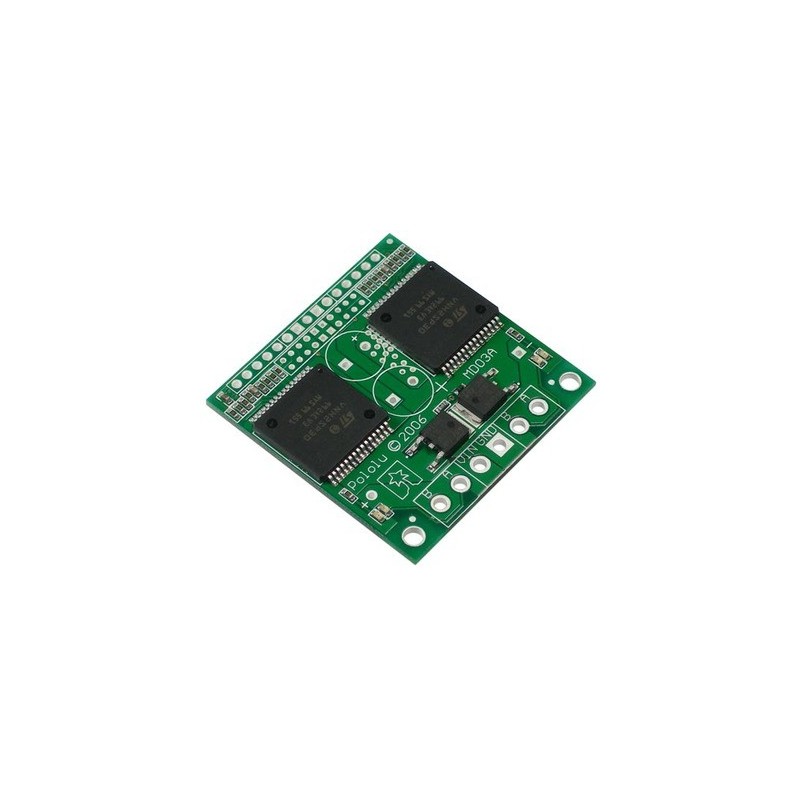



865,48 zł Netto
Dual VNH2SP30 Motor Driver Carrier MD03A umożliwia wydajne i bezpieczne sterowanie dwoma silnikami DC w robotach mobilnych oraz układach napędowych. Moduł sprawdza się w projektach wymagających dużej mocy, niezależnej kontroli silników i wysokiej odporności na przeciążenia. Pololu 708
Pololu 708 – Dual VNH2SP30 Motor Driver Carrier MD03A przeznaczony do sterowania dwoma silnikami prądu stałego w projektach robotycznych i mechatronicznych wymagających obsługi podwyższonych prądów. Moduł oparty na dwóch mostkach H VNH2SP30 umożliwia niezależną regulację prędkości i kierunku obrotów każdego silnika, co pozwala na realizację napędu różnicowego w platformach mobilnych.
Sterownik współpracuje z mikrokontrolerami poprzez sygnały logiczne oraz sterowanie PWM, zapewniając płynną regulację pracy silników. Zintegrowane zabezpieczenia chronią układ przed przegrzaniem, przeciążeniem oraz zwarciem, zwiększając niezawodność w zastosowaniach prototypowych i eksploatacyjnych. Konstrukcja nośna ułatwia integrację z systemami zasilania i elementami wykonawczymi w robotach oraz pojazdach autonomicznych.
Cechy
Producent BTC Korporacja sp. z o. o. Lwowska 5 05-120 Legionowo Polska sprzedaz@kamami.pl 22 767 36 20
Osoba odpowiedzialna BTC Korporacja sp. z o. o. Lwowska 5 05-120 Legionowo Polska sprzedaz@kamami.pl 22 767 36 20
Automotive fully integrated H-bridge motor driver, MultiPowerSO-30, STM, RoHS
Brak towaru
Moduł ze sterownikiem silników prądu stałego oparty na układzie MC33886. Pozwala na kontrolowanie ruchu napędów o napięciu pracy od 5 do 28 V i prądzie do 5 A
Brak towaru
Pololu G2 24v12 High Power to miniaturowy sterownik silnika DC. Zasilanie sterownika: 6,5...30V. Wydajność prądowa modułu: 12A. Moduł posiada zabezpieczenie przed napięciem wstecznym i przepięciami. Pololu 1365
Brak towaru
Zestaw z regulatorem prędkości ESC ODrive3.6 oraz silnikiem BLDC MKS X2212. Sterownik przeznaczony jest do zasilania dwóch trójfazowych silników bezszczotkowych w różnych aplikacjach, takich jak roboty jeżdżące, roboty kroczące czy gimbale. Obsługuje zakres napięcia wejściowego od 12 V do 56 V oraz maksymalny prąd do 60 A. Makerbase ODrive3.6 Kit
Brak towaru
Panelowy kontroler prędkości silnika szczotkowego UX-52 to wszechstronne urządzenie z regulacją prędkości od 90 do 1400 obr./min. Oferuje precyzyjną kontrolę nad silnikami o napięciu wejściowym 220VAC, charakteryzując się solidną konstrukcją i wygodnym wyświetlaczem cyfrowym.
Pololu Low-Voltage Dual Serial Motor Controller umożliwia sterowanie dwoma silnikami DC z wykorzystaniem prostego interfejsu szeregowego. Układ sprawdza się w kompaktowych robotach i pojazdach mobilnych, gdzie wymagane jest precyzyjne sterowanie napędem przy niskim napięciu zasilania. Pololu 120
Moduł 2-kanałowego sterownika silników szczotkowych z funkcją miksowania sygnałów PWM. Pozwala sterować dwoma silnikami DC o poborze prądu do 5 A na kanał
Moduł z 2-kanałowym sterownikiem silników DC L298P. Płytka została wyposażona w złącze Grove i komunikuje się przez interfejs I2C. Seeed Studio 105020093
Moduł sterownika ESC do silnika bezszczotkowego o wydajności prądowej do 120 A. Może współpracować z pakietami LiPo od 5S do 12S. Wykorzystuje oprogramowanie BLHeli_32. FLYCOLOR X-CROSS HV
Moduł ze sterownikiem silnika krokowego oparty na układzie DRV8434A. Pozwala na zasilanie silnika bipolarnego prądem do 1,2 A na fazę i napięciem od 4,5 V do 45 V. Komunikacja przez interfejs SPI. Pololu 3767
Brak towaru
Podwójny sterownik silników pozwalający na sterowanie dwóch silników DC napięciem 0-11V i prądem ciągłym 1,2A na kanał. Pololu 2135
Pololu G2 24v13 High Power to miniaturowy sterownik silnika DC. Zasilanie sterownika: 6,5 - 40 V. Wydajność prądowa modułu: 13 A. Moduł posiada zabezpieczenie przed napięciem wstecznym i przepięciami. Pololu 2992
Brak towaru
Sterownik silnika prądu stałego (DC) o napięciu pracy 6,5-40V i maksymalnym prądzie ciągłym 13A. Posiada możliwość łatwej realizacji pętli sprzężenia zwrotnego oraz liczne interfejsy sterujące. Pololu 3147
Jednokanałowy sterownik silników DC z interfejsem I2C. Jest zasilany napięciem od 1,8 V do 22 V i może dostarczyć prąd o natężeniu do 1,8 A. Płytka z przylutowanymi złączami. Pololu 5074
Dwukanałowy sterownik silników DC z interfejsem I2C. Jest zasilany napięciem od 4,5 V do 48 V i może dostarczyć prąd o natężeniu do 1,8 A na silnik. Płytka z przylutowanymi złączami. Pololu 5064
Brak towaru
Moduł ze sterownikiem silnika DC DRV8830 o maksymalnym prądzie do 1 A. Płytka została wyposażona w złącze śrubowe i komunikuje się przez interfejs I2C. Pimoroni PIM479
Dwukanałowy sterownik KAmod Motor Driver TB6612FNG z mostkami H MOSFET umożliwia precyzyjne sterowanie silnikami DC i krokowymi z częstotliwością PWM do 100 kHz. Kompaktowa konstrukcja, szeroki zakres napięcia i zabezpieczenia czynią moduł odpowiednim do projektów mobilnych, robotyki i automatyki.

Dual VNH2SP30 Motor Driver Carrier MD03A umożliwia wydajne i bezpieczne sterowanie dwoma silnikami DC w robotach mobilnych oraz układach napędowych. Moduł sprawdza się w projektach wymagających dużej mocy, niezależnej kontroli silników i wysokiej odporności na przeciążenia. Pololu 708
